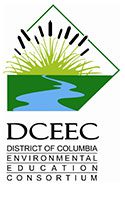Environmental Literacy
Environmental Literacy, for the District of Columbia, is the development of knowledge, attitudes, and skills necessary to make informed decisions concerning the relationships between natural and urban systems.
An environmentally literate person (as defined in the DC Environmental Literacy Plan, 2014):
- Can discuss and describe ecological and environmental systems and human impacts on these systems;
- Engages in hands-on, outdoor learning experiences that involve discovery, inquiry, and problem solving;
- Is able to question and analyze information pertaining to his or her surrounding environment; and
- Has the capacity to take actions that respect, restore, protect, and sustain the health and well-being of human communities and environmental systems.
DC Healthy Schools Act (HSA) and the DC Environmental Literacy Plan (ELP)
With the passage of the HSA, legislation mandated the development of the ELP, to create a framework of standards, professional development, assessment, and leadership for individuals and organizations to thrive and achieve innovation in education. Plans should include:
- A description of how the state agencies will measure the environmental literacy of students.
- Content standards and how they relate to environmental literacy.
- A description of programs for professional development of teachers.
- Must address the relationship of the plan to graduation requirements.
- A description of how the plan will be implemented.
- The plan must specify who will be involved in review, and include stakeholders such as State Education agencies, non-profits, federal agencies, etc.
As mandated by the HSA, the District Department of the Environment (DDOE) formed the DC Environmental Literacy Plan workgroup (Anacostia Watershed Society, DCEEC and other DC agencies) to draft the following sections:
- Content Standards and Professional Development
- Graduation Requirements and Evaluation
- Implementation and Funding
The ELP was submitted to DC Council in June of 2012, passed unanimously and signed by Mayor Vincent Gray in July 2012. The Sustainable DC Omnibus Amendment Act of 2014 created an environmental literacy program at the Office of the State Superintendent of Education, which monitors implementation.
The Environmental Literacy Plan and implementation updates can be found here.
Full implementation reports are part of Healthy Schools Act reporting requirements, found here.
Implementation of the Environmental Literacy Plan
In 2013, DCEEC, Anacostia Watershed Society, and DC Greens formed a partnership and proposed a two year pilot project to the Department of Energy and Environment to create a strong school-based foundation for a Sustainable DC. The pilot collaborated with teachers and schools to develop a guide for schools that identified the knowledge and skills District students need to become environmentally literate. The partnership worked with four elementary schools, two middle schools, and two high schools, representing each ward of the District and split between DC Public Schools and public charter schools. Dubbed the Sustainable DC Model Schools, DCEEC and its partners developed a strategy to identify an Environmental Literacy Coordinator at each school. For two years, the partners and Environmental Literacy Coordinators, each with their expertise, met monthly and developed and piloted the Environmental Literacy Framework (ELF). From 2014-15, the eight Sustainable DC Model Schools developed and implemented their school’s environmental literacy plans using the ELF as a guideline. This pilot project informed the creation of the Office of the State Superintendent of Education’s Environmental Literacy Leadership Cadre program.
Interested in learning more?
Please complete this form to stay connected.
You will have the option to be added to our GoogleGroup listserv.
Questions? Send us an email!
